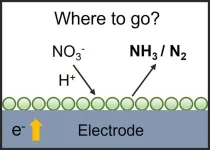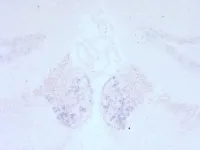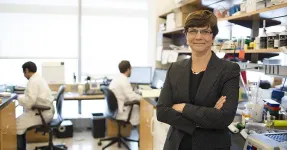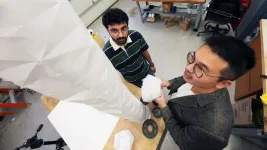(Press-News.org) Love is blind, the saying goes, and thanks to a world-first Australian study, we are now a step closer to understanding why.
It is well known that romantic love changes the brain, releasing the so-called love hormone oxytocin, responsible for the euphoria we feel when falling in love.
Now, researchers from the ANU, University of Canberra and University of South Australia have measured how a part of the brain is responsible for putting our loved one on a pedestal in that first flush of romance.
In the world’s first study investigating the link between the human brain’s behavioural activation system (BAS) and romantic love, researchers surveyed 1556 young adults who identified as being “in love”.
The survey questions focused on the emotional reaction to their partner, their behaviour around them, and the focus they placed on their loved one above all else.
It turns out that when we are in love, our brain reacts differently. It makes the object of our affections the centre of our lives.
ANU lead researcher and PhD student Adam Bode says the study – recently published in the journal Behavioural Sciences – sheds light on the mechanisms that cause romantic love.
“We actually know very little about the evolution of romantic love,” Bode says. As a result, every finding that tells us about romantic love’s evolution is an important piece of the puzzle that’s just been started.”
“It is thought that romantic love first emerged some five million years ago after we split from our ancestors, the great apes. We know the ancient Greeks philosophized about it a lot, recognising it both as an amazing as well as traumatic experience. The oldest poem ever to be recovered was in fact a love poem dated to around 2000 BC.”
University of Canberra academic and UniSA Adjunct Associate Professor, Dr Phil Kavanagh, says the study shows that romantic love is linked to changes in behaviour as well as emotion.
“We know the role that oxytocin plays in romantic love, because we get waves of it circulating throughout our nervous system and blood stream when we interact with loved ones,” Dr Kavanagh says.
“The way that loved ones take on special importance, however, is due to oxytocin combining with dopamine, a chemical that our brain releases during romantic love. Essentially, love activates pathways in the brain associated with positive feelings.”
The next stage of the research involves investigating the differences between men and women in their approach to love, and a worldwide survey identifying four different types of romantic lovers.
Notes to editors
“Romantic Love and Behavioural Activation System Sensitivity to a Loved one” is published in Behavioural Sciences. DOI: 10.3390/bs13110921
END
Love scrambles the brain and scientists can now tell us why
2024-01-09
ELSE PRESS RELEASES FROM THIS DATE:
Where to go with nitrate electroreduction reaction?
2024-01-09
Ammonia is a necessary feedstock to produce nitrogen-based fertilizers, chemicals, pharmaceuticals, and polymers. To date, about 80% of global ammonia is used to produce nitrogen-based fertilizers which relates to 50% of global food production. The global production of ammonia is about 180 million metric tons per year through the carbon-intensive and highly energy-consuming Haber-Bosch process. The high energy consumption, high carbon intensity, and high capital investment of the Haber-Bosch process make the development of environmentally sustainable and affordable routes for ammonia synthesis under ambient conditions more urgent. The electrochemical ammonia ...
Measuring grass pollen allergens instead of grass pollen count will help hay fever sufferers
2024-01-09
Measuring airborne grass allergen levels instead of pollen counts will be more beneficial for hay fever sufferers as new research shows grass allergen levels are more consistently associated with hay fever symptoms than grass pollen counts.
The research, published today in The Journal of Allergy and Clinical Immunology and led by King’s College London and Imperial College London, shows for the first time that measuring airborne allergen levels will help people with hay fever better control their symptoms.
1 in 4 adults in the UK suffer from hay fever from late-March to September. Symptoms include a runny or blocked ...
Clear link between autoimmune disease and perinatal depression
2024-01-09
Women with autoimmune disease are more likely to suffer from depression during pregnancy and after childbirth; conversely, women with a history of perinatal depression are at higher risk of developing autoimmune disease, a new study from Karolinska Institutet published in the journal Molecular Psychiatry reports.
In autoimmune disease, the immune system mistakenly attacks the body’s own healthy tissue. Some of the most common autoimmune diseases are gluten intolerance (coeliac disease), autoimmune thyroiditis, rheumatoid ...
Diagnostic errors are common in seriously ill hospitalized adults
2024-01-09
A study of seriously ill patients from academic medical centers across the country has found that nearly a quarter had a delayed or missed diagnosis.
All the patients had either been transferred to the intensive care unit (ICU) after being admitted or died in the hospital. The researchers concluded that three-quarters of these diagnostic errors contributed to temporary or permanent harm, and that diagnostic errors played a role in about one in 15 of the deaths.
The most common errors identified in the study involved delayed rather than missed diagnoses, for example because a specialist was consulted too late or an alternate diagnosis was not considered ...
Scripps Research scientists give new insight into a molecular target of alcohol
2024-01-09
LA JOLLA, CA— Ethanol—the compound found in alcoholic beverages—interferes with the normal functioning of a long list of biological molecules, but how each of these interactions contributes to the behavioral effects of alcohol is not fully understood. A guiding, but elusive, goal of researchers is to identify the protein (or proteins) to which ethanol binds that makes some people vulnerable to excessive drinking. Solving this question would point the way to effective therapies for alcohol use disorder, ...
Coastal populations set to age sharply in the face of climate migration, FSU researcher finds
2024-01-09
As climate change fuels sea level rise, younger people will migrate inland, leaving aging coastal populations — and a host of consequences — in their wake, a study by Florida State University researchers finds.
While destination cities will work to sustainably accommodate swelling populations, aging coastal communities will confront stark new challenges, including an outflow of vital human infrastructure such as health care workers, said Associate Professor of Sociology Matt Hauer, lead author of the study published in the Proceedings of the National Academy of ...
World-renowned surgeon named new director of Moores Cancer Center at UC San Diego Health
2024-01-09
Following an extensive national search, Diane M. Simeone, MD, has been appointed director of Moores Cancer Center at UC San Diego Health, effective April 1, 2024.
Simeone brings robust institutional, national and international leadership experience to both oncologic patient care and scientific research, with a focus on establishing novel models of interdisciplinary collaboration. She is an internationally recognized surgeon-expert in the biology and multidisciplinary treatment of pancreatic neoplasms, with an active clinical practice in pancreatic surgery.
Simeone currently serves as the Laura and Isaac Perlmutter ...
Origami-inspired robotic plants grow with their environment
2024-01-08
How do you deploy an environmental sensor to collect climate change readings over a prolonged period on an uninhabited island without failing? How do you power a seismic detector to operate for months in an underwater cave?
In environments that are difficult to reach because of the hazards or hardships for humans, a device behaving like a native plant could be the answer. This is the approach taken by Suyi Li, associate professor in mechanical engineering at Virginia Tech, and Clemson professor and collaborator Ian Walker. Their work is being advanced ...
New research identifies high rates and common causes of diagnostic errors in hospitals across the nation
2024-01-08
Almost a quarter of patients who were admitted to the ICU or died in 29 hospitals in the United States experienced a diagnostic error
Efforts and initiatives are underway across the country to address and prevent the causes of diagnostic errors
A new study from researchers from Brigham and Women’s Hospital, a founding member of the Mass General Brigham healthcare system, in collaboration with researchers at the University of California San Francisco, has shed light on the rate and impact of diagnostic errors in hospital settings. In an analysis of electronic health records from 29 hospitals across the country of 2,428 patients who ...
Final supernova results from Dark Energy Survey offer unique insights into the expansion of the universe
2024-01-08
In 1998, astrophysicists discovered that the universe is expanding at an accelerating rate, attributed to a mysterious entity called dark energy that makes up about 70% of our universe. While foreshadowed by earlier measurements, the discovery was somewhat of a surprise; at the time, astrophysicists agreed that the universe’s expansion should be slowing down because of gravity.
This revolutionary discovery, which astrophysicists achieved with observations of specific kinds of exploding stars, called type Ia (read “type one-A”) ...





